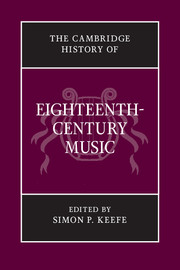Book contents
- Frontmatter
- PRELUDE
- PART I MUSIC FOR THE CHURCH
- INTERLUDE
- PART II MUSIC FOR THE THEATRE
- INTERLUDE
- PART III MUSIC FOR THE SALON AND CONCERT ROOM
- 16 Keyboard music from Couperin to early Beethoven
- 17 The serenata in the eighteenth century
- 18 Private music in public spheres: chamber cantata and song
- 19 Handel and English oratorio
- 20 The overture-suite, concerto grosso, ripieno concerto and Harmoniemusik in the eighteenth century
- 21 Concerto of the individual
- 22 Eighteenth-century symphonies: an unfinished dialogue
- 23 The string quartet
- POSTLUDE
- Appendix I Chronology
- Appendix II Institutions in major European cities
- Appendix III Personalia
- Index
- References
23 - The string quartet
from PART III - MUSIC FOR THE SALON AND CONCERT ROOM
Published online by Cambridge University Press: 28 March 2011
- Frontmatter
- PRELUDE
- PART I MUSIC FOR THE CHURCH
- INTERLUDE
- PART II MUSIC FOR THE THEATRE
- INTERLUDE
- PART III MUSIC FOR THE SALON AND CONCERT ROOM
- 16 Keyboard music from Couperin to early Beethoven
- 17 The serenata in the eighteenth century
- 18 Private music in public spheres: chamber cantata and song
- 19 Handel and English oratorio
- 20 The overture-suite, concerto grosso, ripieno concerto and Harmoniemusik in the eighteenth century
- 21 Concerto of the individual
- 22 Eighteenth-century symphonies: an unfinished dialogue
- 23 The string quartet
- POSTLUDE
- Appendix I Chronology
- Appendix II Institutions in major European cities
- Appendix III Personalia
- Index
- References
Summary
By the end of the eighteenth century, the string quartet had achieved a status beyond that of most other instrumental genres, a status that made it appealing as a hook on which to hang historical reputations. And this, in turn, sometimes meant creating convenient histories – or, by the early decades of the nineteenth century, asserting the importance of ‘great men’, their originality and independence of mind, their historical leadership, in whatever field:
The following purely chance circumstance had led [Haydn] to try his luck at the composition of quartets. A Baron Fürnberg had a place in Weinzierl. . . and from time to time he invited his pastor, his manager, Haydn and Albrechtsberger (a brother of the celebrated contrapuntist, who played the violoncello) to have a little music. Fürnberg requested Haydn to compose something that could be performed by these four amateurs. Haydn, then eighteen years old, took up this proposal and so originated his first quartet which, as soon as it appeared, gained such general approval that Haydn was encouraged to work further in this form.
- Type
- Chapter
- Information
- The Cambridge History of Eighteenth-Century Music , pp. 648 - 660Publisher: Cambridge University PressPrint publication year: 2009
References
- 1
- Cited by

